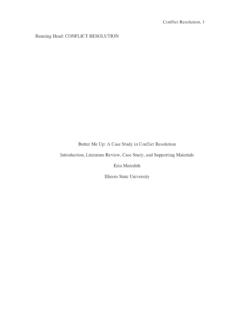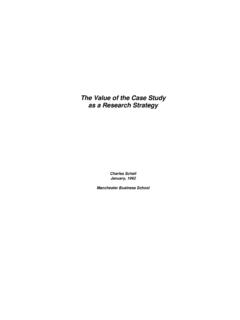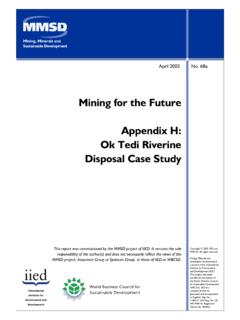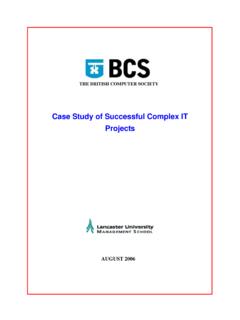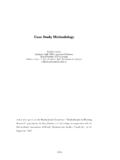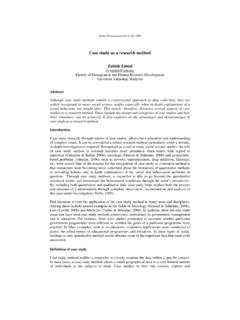Transcription of 3DM Analyst Case Study - ADAM Tech
1 12/01/05 1 of 4 3dm analyst case study Jason Birch, ADAM Technology Introduction 3DM Analyst is a new, digital photogrammetric system developed by ADAM Technology specifically to take advantage of the advances in digital photography in recent years. It represents the culmination of nine years research and development in digital photogrammetry and builds on ADAM s 18-year history designing and manufacturing analytical stereoplotters and the associated mapping software. 3DM Analyst has been sold to mapping, surveying, and mining companies in Australia, Indonesia, Japan, Canada, and the United States. Coal-mining users of the software include BMA Coal and Griffin Coal in Australia and BHP Billiton New Mexico Coal in the USA. The software operates on stereo image pairs overlapping images of a scene captured from two different locations. Usage is straightforward: images are captured using a digital camera and then loaded into the software, which then automatically determines the relationship between the cameras at the time the images were captured (Figure 1).
2 Data can be registered in real-world co-ordinates in a variety of ways, but generally the easiest method is to use a combination of control points and/or camera stations. The software then processes the images to automatically generate a 3D surface, typically consisting of between 100,000 and 250,000 points with images taken from a six megapixel digital camera (Figure 2). The total time required from first loading the images to having the completed 3D model of the surface is about six minutes on a modern PC, and the most time-consuming stages can be processed in batch mode with many other projects without user intervention ( overnight) to minimise operator costs. The user can manually digitise vector data (including breaklines) using a range of methods within 3DM Analyst itself, and the software can automatically generate contours and cross-sections if desired.
3 The 3D data can also be exported as a 3D Image that can be loaded into other mining software packages, such as Maptek s Vulcan, for reconciliation and geotechnical analysis (Figure 3). Contours, cross-sections, and the surface itself can also be exported in DXF format for use in packages like Surpac, and, for aerial images, georeferenced ortho images can also be exported for use in packages like Trimble s Terramodel. Figure 1. A stereo image pair loaded into 3DM Analyst ready to be processed. The green cross is on a control point, used for registering the data in real-world co-ordinates. Relative-only points can be generated automatically by the software. Figure 2. A 3D view of the automatically-generated surface model with the original image draped over it. The surface can be rotated to any angle, and vector data can be digitised directly in 3D in this view.
4 Other digitising methods are also supported stereo digitising in the Stereo View and Single Image Digitising in the Images View. ADAM Technology 3dm analyst case study 12/01/05 2 of 4 Figure 3. A 3D Image of the pit wall of BMA's Goonyella Riverside mine loaded into Vulcan for geological and geotechnical interpretation. Figure 4. The 3D camera orientations of a series of images as determined by 3DM CalibCam. Automatically-located common points in the images are used to share orientation information between images, minimising the number of control points required. 3DM Analyst can also be used in conjunction with a companion product, 3DM CalibCam. This allows any number of images to be processed at once for the purpose of computing the camera orientations, greatly reducing the number of control points required to accurately register data in real-world co-ordinates (Figure 4).
5 In one trial, the data generated from a strip of 37 overlapping images was shown to be accurate to better than 6cm using just one control point in addition to the surveyed camera stations. (More control points are generally used in practice to increase redundancy and reduce the effect of bad observations.) It also allows multiple images captured from the same location to be merged into a single, large image, allowing arbitrarily large images to be created from even very modest digital cameras and used directly in 3DM Analyst (Figure 5). Figure 5. A pair of images captured from the same location merged into a single, large image by 3DM CalibCam, with all lens distortions and colour differences removed. Merging accuracy is approximately pixels. ADAM Technology 3dm analyst case study 12/01/05 3 of 4 case Study BMA Coal BHP Billiton Mitsubishi Alliance (BMA) is Australia s largest coal producer, with a capacity to produce over 50 million tonnes of coal per year.
6 Approximately 170km of pit wall are exposed at any given time. A mine site like BMA s Goonyella Riverside mine develops approximately 30km of new high wall faces per year, requiring a large amount of safe and accurate high wall mapping, often with a short window of only two to three hours to carry out mapping of a large segment of high wall. Already operating a laser scanner at its Blackwater mine, BMA decided to investigate the new digital photogrammetric systems with a view to meeting its high wall mapping needs and in March of 2004 conducted an extensive onsite trial comparing 3DM Analyst with another digital photogrammetric system. BMA concluded that the ADAM Technology software is more accurate, faster, more flexible, easier to use, more robust and more rapidly developing, provides better quality models, has better software support and requires less training.
7 Based on technical considerations of the trial results, ADAM Technology's 3DM Analyst plus CalibCam softwares provide the best solutions for BMA's high wall mapping. BMA subsequently purchased two licences each of 3DM Analyst and 3DM CalibCam one set for its Central Queensland Office, to be used by its Geological and Geotechnical Services groups for geological and geotechnical analysis of all of BMA s mines, and another set for the Goonyella Riverside mine s Technical Services Department to use as part of its general operations to survey the top of coal for resource modelling as well as the crest and toe of the pit walls. The Central Queensland Office uses an 11-megapixel Canon EOS 1Ds digital SLR, while Goonyella Riverside uses an 8-megapixel Canon EOS 1D Mark II digital SLR. Both cameras are equipped with a range of fixed (prime) lenses from 28mm to 85mm focal lengths to provide flexibility in the choice of accuracy and working distance.
8 Operation The main use of 3DM Analyst at BMA is for high wall mapping. The usual method of operation is to capture a series of images looking directly at the wall from as far away as possible, with each image overlapping its two neighbours by about 60% (Figure 6). In this case , due to safety and access restrictions on the low wall, images are captured from the pit floor. As a consequence, the long and narrow shape of BMA s pits limits the maximum typical distance to about 50m on average and the pit wall coverage per image to about 60m. While this results in very detailed images with much higher accuracies than required (10 20mm), it also means many more images are captured and processed than would normally be the case . (Other users, with much larger pits, are able to take images from over 1,000m away, capturing in excess of 250m of pit wall in each image while still achieving better than 10cm accuracy.)
9 This greatly reduces the amount of fieldwork required.) Figure 6. Strip of overlapping images, as used in Figure 4. One control point is placed and surveyed for every fifth image or so, or approximately every 120m. Using this method, 1000m of pit wall can be completely captured by a two-man team in about hours. Processing the images back in the office generally takes half a day to a day. Compared to the old manual surveying techniques, the new approach has demonstrated the following advantages: 1. Personnel now spend much less time in the field what used to take 5 6 hours in the field now takes less than 2 hours of field time. 2. The amount of detail is far greater than ever before, greatly improving the accuracy of the resource model. 3. The images form a complete and permanent record that can always be referred back to later to pick up more detail long after the wall itself has gone.
10 For example, 3D Images originally used by Goonyella Riverside for general operations can also later be used by the Central Queensland Office s Technical Services groups for geological and geotechnical interpretation. Now that the technology has proven itself, Goonyella Riverside are also considering changing their operating procedures to provide safe access to the low wall in order to capture images from a greater distance with a view to further improving productivity. ADAM Technology 3dm analyst case study 12/01/05 4 of 4 Paradoxically, rather than reducing the workload on the technical services personnel by improving their productivity, the Goonyella Riverside Technical Services Department has found that customer expectations have greatly increased and they are now required to perform a substantial amount of new measurement that wasn t required of them before ( cast blasts and engineering surveys in general where access is limited).
